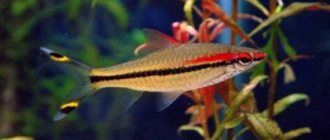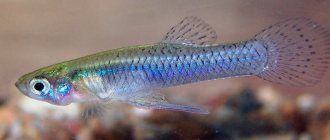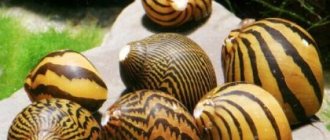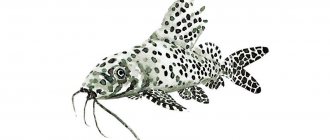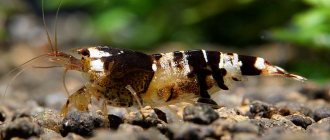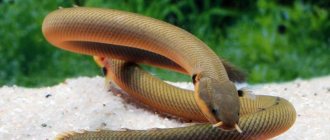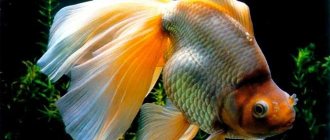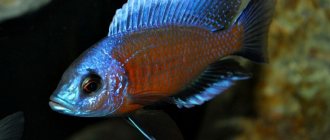Barbs, also known as “Barbels,” also known as “Puntiuses,” deserve special attention from aquarists as the most interesting genus of ray-finned fish for its species diversity, capable of satisfying most of the aesthetic preferences of home aquarium owners.
According to ichthyologists, who prefer to call Barbus “Barbel” Puntius, more than two thousand species of this fish have been recorded in nature. Of these, about forty species, selected by breeders, have successfully established themselves in household aquariums around the world.
Description
The firefish lives in rivers and lakes of India, Australia and New Zealand. The veil and neon forms of the fiery barb have been artificially bred. Subspecies are able to interbreed and produce offspring.
Appearance
The oblong body of the barb is pale gold to red in color. It grows up to 10 cm. The scales shimmer in the light, resembling a flame in appearance. The back is greenish, the belly of males is red, the fins are translucent with a dark edging. There is a dark dot near the tail.
Behavior
Puntiuses cannot be called harmless. Fire barbs bite the veil and filament fins of other aquarium fish. Barbs are active and cheerful. They feel good in a flock of 6 or more individuals.
Lifespan
The fiery inhabitants of the aquarium live up to 5 years.
Table of differences between subspecies
Range and habitat
Inhabits standing and slow-flowing waters in the northeastern regions of India, Pakistan, Bangladesh, Nepal, and Afghanistan. Wild populations exist in several other countries, notably Singapore, Australia, Mexico, Puerto Rico and Colombia.
Populations show some variation depending on location, with some forms growing larger than others or having changes in color and pattern.
For example, fish found in the Darjeeling region of the Siwalik hills of West Bengal are said to be particularly well-colored with highly reflective scales.
Wild specimens are not usually available in the aquarium trade; the vast majority are bred commercially.
Content
Fire punts are suitable for beginners as their first fish. There are no special requirements for keeping barbs; it is only important to provide cool water.
Aquarium
To keep a flock of 6 individuals, select an aquarium of 80 liters or more. A lid is required to prevent the fiery punts from jumping out of the water. Place shelters and decorations:
- grottoes;
- caves;
- driftwood;
- artificial plants;
- stones.
- hornwort;
- nayas;
- Java moss;
- arrowhead;
- cabomba.
- sand;
- small pebbles;
- fine gravel.
Water parameters
| Water temperature | 16–24 degrees |
| Acidity | 6–8 pH |
| Rigidity | 4–18 dGh |
Change up to 25% of the water and siphon the soil weekly. Barbs have a peculiarity of keeping: they require a moderate current. You can create water movement using a filter flow.
Plants
Place plants in the corners of the aquarium and in the background. Choose small-leaved species, as wide leaves will be plucked:
Priming
On the bottom you can place:
If the primer is artificially colored, make sure the dye is non-toxic. Choose a dark substrate: fire barbs stand out against its background, and dark soil does not reflect light and does not cause discomfort to the fish.
Equipment
You can't do without a filter and an aerator. A heater is not required if the room temperature is at least 20 degrees. Equip your aquarium with a thermometer to monitor the temperature. During hot weather, cool the water with ice packs and increase aeration.
Lighting
Create moderate lighting in the aquarium. The length of daylight hours is no more than 12 hours. The beauty of the fiery scales of the Puntius is revealed in the sunlight. Remember that the sun's rays provoke the growth of algae, so their exposure should be no more than 1-2 hours a day.
Compatibility with other fish
The fire barb in a school is quite peaceful, but it can cause harm to fish with long fins, like the lalius or betta, so it is better not to house them together.
Slow swimmers and livebearers are also not suitable. Poor compatibility between fire barb and guppies, angelfish, astronotuses, gastromyzons.
Ideal neighbors are also active fish (for example, good compatibility with labeo bicolor or ternation) and lovers of cool water (for example, cardinals or panda catfish). You can have swordtails, botia, gourami and zebrafish in one aquarium.
Some species sometimes coexist peacefully, but in some cases they do not get along (for example, the ramirezi apistogramma fish or the turquoise acara).
Different species live well together: for example, scarlet barbs or titko barbs can be added to fiery ones.
Feeding
The diet of omnivorous fish should contain:
Serve plant foods once a week. In addition to dry food, give your firefish live or frozen food. Feed your pets several times a day in small portions. The food should be eaten within a couple of minutes. Special food for barbs will help enhance the color.
Nutrition
The menu of fire barbs is nothing short of delightful. They eat everything.
Live food:
- Daphnia,
- Cyclops,
- Tubifex,
- Bloodworm,
- Fillet of any white fish,
- Shrimps,
- Boiled eggs.
Dry vegetable food. Fresh herbs and vegetables:
- Salad,
- Cabbage,
- Dandelion leaves,
- bell pepper,
- Carrot.
Reproduction
To successfully breed fire barbs, prepare a spawning tank with a volume of at least 30 liters. Place Java moss and a separator net at the bottom.
Sex differences
Barbs can reproduce when they grow up to 6 cm, which is when the sex of the fish can be determined. Females are paler, rounder and shorter than males. The color of males becomes more colorful before spawning.
Spawning
A week before breeding, feed your fish a high protein diet. Make frequent water changes and raise the temperature a couple of degrees. Place a male and 1-2 females in the spawning tank. Spawning begins in the morning.
The female lays up to 200 eggs, which fall under the net. Place the breeders in a common aquarium so that the offspring are not in danger. After 2 days, larvae will hatch from the eggs, which will swim independently after another 2 days.
Feed the fry:
Friendly neighborhood
Fire barbs are peace-loving fish, but their insatiable passion for games can affect their proximity to veiled pets. Barbs can pinch beautiful fins for fun.
“Ogonki” are schooling fish. Loneliness weighs heavily on them and can lead to stress. Following this, outbursts of irritation will certainly begin and they will not give passage to the neighbors.
For a serene life in an aquarium, all other types of barbs, mollies, rainbowfish, catfish are suitable, that is, all those fish that are similar in character, size and care requirements.
But cockerels and goldfish with their veiled fins and tails will only excite the barb into small dirty tricks and he will definitely bite off all the beauty. Guppies can also suffer from their attacks. Slow fish will get tired of endless flickering. All large predators, such as cichlids, pose a danger to fire barbs.
Diseases
Fire punts get sick due to improper living conditions and poor care.
Ammonia poisoning
Poisoning occurs due to infrequent water changes and overcrowding. The pet's gills turn red, it predominates in the upper layers of water, and breathes rapidly. Check whether the level of hazardous substances in the water is exceeded by tests. Improve aeration and replace the water with fresh water with similar parameters. Control the population in the aquarium; it may be necessary to transfer several individuals to another container.
Camallanides
Parasites are introduced through untreated live food. Treat with fenbendazole or piperazine mixed with food or in a medicated bath.
Dropsy
The disease is characterized by an enlarged abdomen. Change 25% of the water every other day, feed high-quality food. Add antibacterial drugs to the water.
Ichthyophthiriasis
White dots appear on the body and fins. Treat ichthyophthyriasis with medications from a pet store. Treatment is accompanied by an increase in temperature and increased aeration. You can prevent the disease from being introduced into the aquarium by keeping new fish in quarantine for 3 weeks.
Fin rot
A sick individual loses appetite and exhibits depressed behavior. The fins are damaged and in the final stages are completely destroyed. Treat illness with salt baths.
Oxygen starvation
Oxygen deficiency occurs due to high temperatures, overcrowding or poor aeration. Check the quality and parameters of the water with tests. Determine the cause of oxygen starvation and take action: cool the water and turn off the lamp, replace some of the water, or if there is no equipment responsible for aeration, purchase it.
Adviсe
- If the barb eats plants, this signals that there are not enough plant components in the diet.
- Have a spare aquarium. It will be needed for spawning, transplantation of sick individuals and quarantine of new ones.
- Treat live food with methylene blue solution before serving.
- Do not use detergents when cleaning the aquarium; always wash your hands when touching the aquarium.
- Use a wide basin to settle the water. Containers with a narrow neck are not suitable.
There are fish similar to the fiery puntius, for example the golden barb (puntius semifasciolatus). The fish is artificially bred and has a similar rich golden color.
Previous
FishBlack Neons - a beautiful fish with a calm temperament
Next
Fish8 common types of aquarium fish platies
Reviews
Aquarists have noticed the tendency of barbs to bite plants and fish fins. For many, the complex nature is compensated by the beauty and unpretentiousness of the pet.
Varieties
“Ogonyok” could not escape its fate and fell into the tenacious hands of breeders. Curious comrades immediately began their painstaking work of breeding new varieties. This is how the veil fire barb, neon fire barb and golden fire barb appeared. The efforts of the breeders were not in vain, and the result was impressive. The differences are obvious: neon and gold in color, veil in the shape of the fins. The aquarium in which such beauty lives becomes fabulous.
Photo gallery
Barb gill rot
This infectious disease especially often affects barbs, which is why it requires attention. The disease is fungal in nature. As a result of the lesion, the vessels in the gills are first blocked, and then destroyed. Rapidly occurring hemorrhages lead to the appearance of a clearly visible symptom of the disease - red gills in barbs. Other signs of the disease are:
- loss of appetite;
- decreased or complete loss of response to stimuli;
- sick fish constantly stays near the surface, but does not swallow air;
- frequent position of the fish upside down (barbs normally only sleep in this position and do not stay in it during the day);
- frequent friction with plants and stones;
- the appearance of dark blue spots on the gills in places where the process of tissue death has begun. It is not uncommon for the gills to change color and become a mosaic pattern with red, blue and off-white areas.
Shortly before death, the fish begins to swim on its side and dies in this position.
The causative agent of branchiomycosis (gill rot) is the bacteria Branchiomyces sanguinis and Branchiomyces demigrans.
Treatment is possible only if the disease is detected early. For therapy, 40 mg/10 l of rivanol is added to the general aquarium (due to the contagiousness of the disease). After 2 weeks, the water is replaced and rivanol is added - 30 mg/10 l and methylene blue - 0.05 g/10 l.
To prevent the disease, 20 mg/10 l of rivanol is added to the water once every 90 days.
Breeding forms with photos
Like most fish, in natural conditions barbs are rather inconspicuous - this is necessary for camouflage from natural enemies. Modern breeders have taken care of species diversity.
Subspecies differ from each other in coloring , but one thing remains the same - three contrasting stripes on the body and one on the head .
Dark green uniform
The mutant barb is dark green, the fins are black with an orange edging.
The dark green form also includes the “green tiger” subspecies. It has a pleasant golden tint and a light belly.
Albino
Albino fish have a light creamy body color, white vertical stripes, and transparent fins.
Platinum
This subgroup includes three types:
- Platinum barb. The body is white, the fins are black.
- Platinum. White with a golden tint, no stripes.
- Green platinum. White-blue hue with black fins.
Veiled
The subspecies differs from the classic form of fish by long fins of a red hue.
Glofish
Genetically modified subspecies of barbs. The body color is red or green, the vertical stripes are black. Otherwise, glos do not differ from ordinary Sumatran barbs.
Mossy
A dark green subspecies without vertical stripes on the body.
Black marble
Another subspecies of genetically modified fish. Their main difference is their black color and ability to glow in ultraviolet light. co
Interesting fact! The Sumatran luminous barb is prohibited for breeding, keeping and selling in some countries of the world.
Strawberry
The fish subspecies is albino, but has a delicate pink color.
Gold
Barbs have a creamy color with a golden tint. Albinos, which also include golden ones, are distinguished by their transparent fins and red head.
Obesity
Barbs have a special appetite, and therefore, if there are errors in feeding, they often develop obesity, which poses a serious danger to pets. If barbs die in an aquarium, when there are no signs of infectious diseases and the water quality is good, then you should think about obesity and look for its symptoms. The main manifestations of pathology have the following characteristics:
- an increase in body circumference, which significantly exceeds the norm (during the spawning period for a female, an increase in the abdomen is the norm);
- decreased physical activity;
- apathy.
The main way to cure obesity is to significantly reduce fish feeding.
To reduce the weight of fish, it is necessary to restore the correct feeding regime for them, and also keep the barbs without food for 2-3 days after discovering the problem in order to start the process of processing fat accumulations. Obesity occurs gradually, and therefore not all owners notice it in a timely manner.


